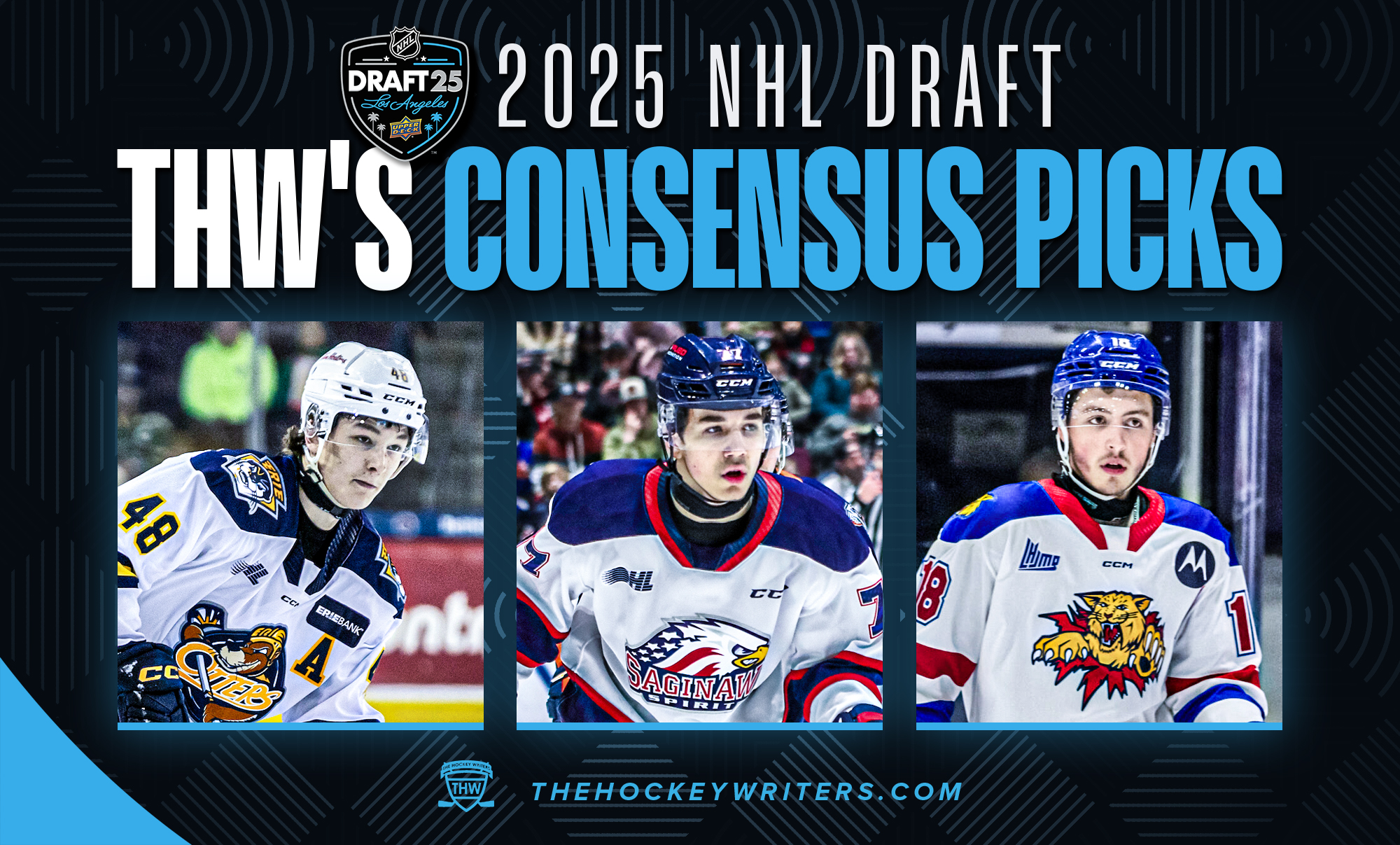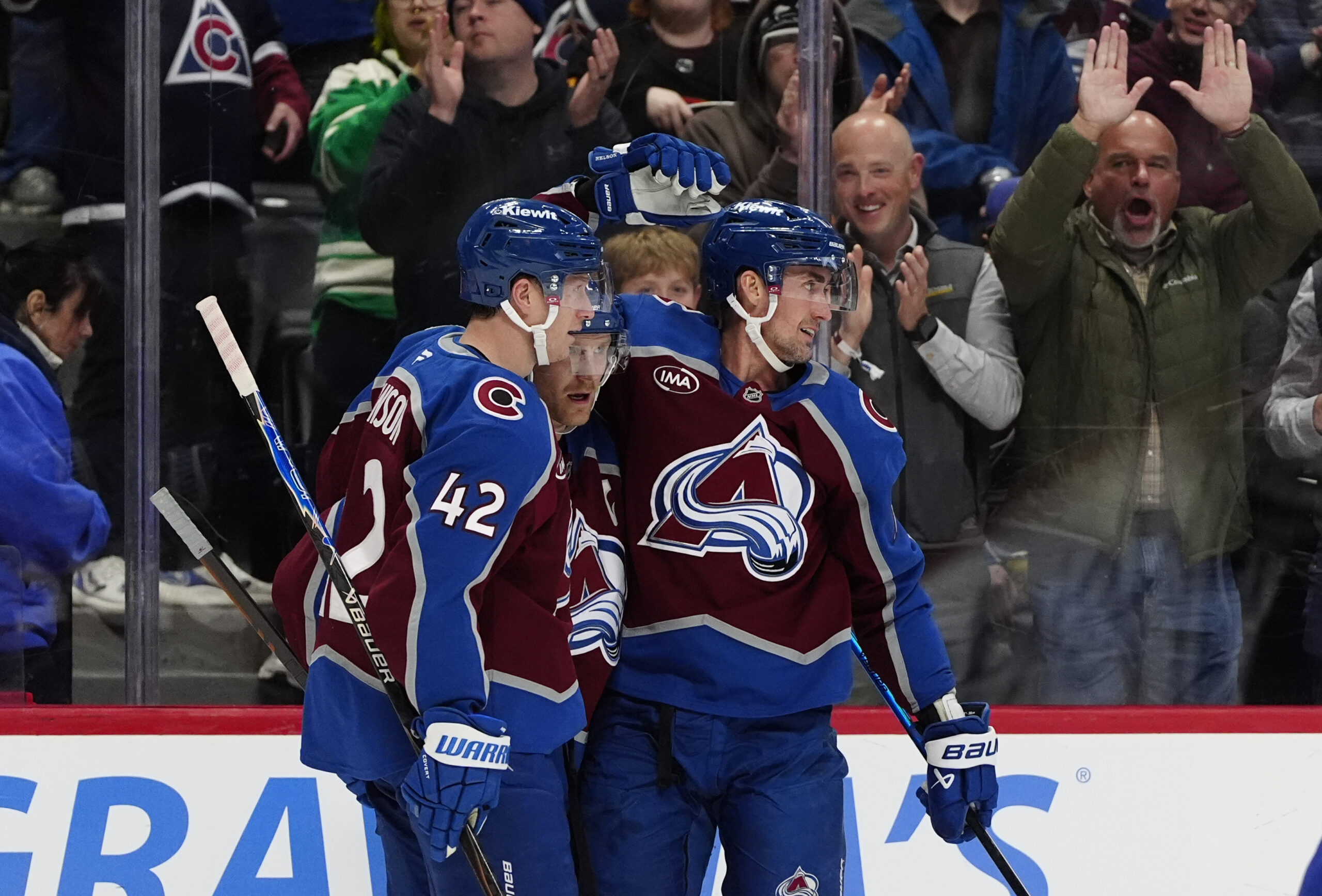Welcome to The Hockey Writers’ Final 2025 Draft Rankings, a combination of the rankings from our top prospects writers. This year’s list is a compilation of Peter Baracchini’s Final Rankings (Top 128), Andrew Forbes’ Final Rankings (Top 128) and my own (Dayton Reimer’s) Final Rankings (Top 96). This list is an average of the top 32 prospects and is organized based on their average draft position. In total, 37 names were included across the three lists, meaning that while we agreed on most of this year’s top prospects, there were some interesting divergences.
Our three writers were unanimous in their selection of the first three selections, placing Matthew Schaefer, Michael Misa, and Caleb Desnoyers, and we were close with our top nine. But we began to diverge on the 10th pick, and I emerged as the biggest outlier. I was much lower on Jackson Smith, Radim Mrtka, and Jacob Ihs-Wozniak and was the highest on Roger McQueen, placing him within my top 10. However, I wasn’t the only contrarian; Andrew was significantly higher on Cameron Reid and was much lower on Vaclav Nestrasil in his rankings. Peter generally fit nicely in the middle, although he remains the most outspoken defender of Bill Zonnon, placing him the highest among the three rankings.
Related: THW 2025 NHL Draft Guide
Thank you all for reading our draft rankings coverage for the 2025 NHL Draft this year. It means so much to us, and your support and readership are what make this work possible. Now, take a look at The Hockey Writers’ combined Top-32 ranking for the 2025 Draft class.
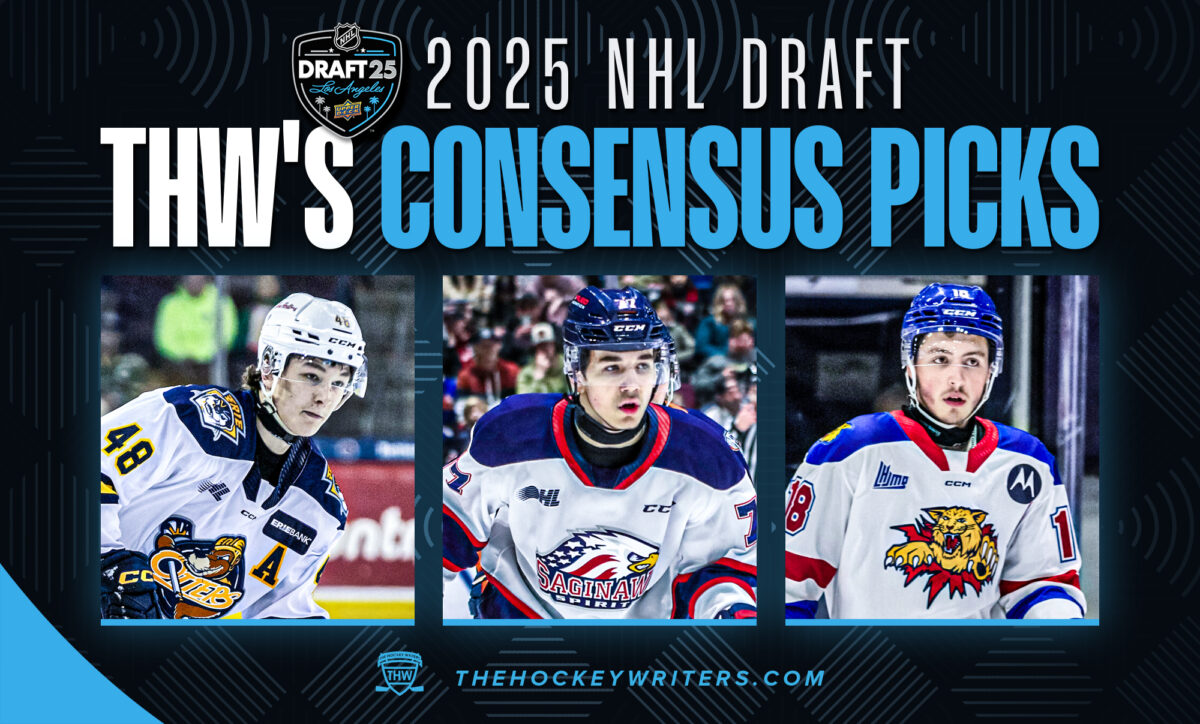
1. Matthew Schaefer, LD, Erie Otters (OHL)
Even though he only played 26 games this season, it was enough for everyone to determine Schaefer as the first overall pick. His smarts, vision and poise are already translating to the NHL level. He has all the trademarks of a first-pairing, number-one defenseman written all over him, as he’s quick in transition, has a high hockey IQ, and knows when to join the rush and attack. He’s a difference-maker, an elite facilitator with the puck from the backend. – Baracchini
2. Michael Misa, C, Saginaw Spirit (OHL)
He cleaned up in the Ontario Hockey League (OHL) this season with 134 points in 65 games, and still, Misa sits as the probable number-two pick. He creates opportunities for himself with his impeccable stick-handling and for his teammates by getting the puck to them even in tight spaces. Offensively, he’s a constant threat with – and without – the puck, but he’s also a 200-foot player who can help in his own end. His type of skill is invaluable. He’s going to make a team incredibly happy with the draft selection. – Forbes
3. Caleb Desnoyers, C, Moncton Wildcats (QMJHL)
My favourite for this spot is Desnoyers. He’s big, he scores goals, and he makes things happen. In the Quebec Maritime Junior Hockey League (QMJHL) playoffs, he was unstoppable, putting up nine goals and 30 points in 19 games en route to claiming the league championship and the Guy Lafleur Trophy as the playoff MVP. He also took home the Mike Bossy Trophy as the league’s best pro prospect, the Paul Dermot Personality of the Year Trophy, and was a QMJHL All-Star. While there are still some concerns about his ability to push the pace of a game, he’s incredibly creative, creates space, and uses his physicality well. His upside is fantastic, which led me to move him up to my third spot. – Reimer
4. James Hagens, C, Boston College (NCAA)
James Hagens has a lot of potential, but the shorter NCAA season could be why he has fallen outside of the top three. Fewer games mean a smaller sample size than other players. That said, Hagens has a ton to offer. He’s deceptive and sees the game extremely well. He picks away at the seams in the opposition, which makes him dangerous in all aspects upfront. He seems to be a couple of steps ahead of the opposition, which allows him to create dangerous opportunities and find his teammates when the gap closes on him. – Baracchini
5. Porter Martone, RW, Brampton Steelheads (OHL)
Porter Martone’s skillset and compete level alone are going to draw a lot of attention from teams, and he’s the kind of winger who will make an impact at the next level. He excels in tight spaces and in front of the net with his quick hands and ability to battle. The combination of his size and tenacity allows him to win battles easily and bully his way past opponents. He’s not afraid to chirp, drop the gloves and get under the opposition’s skin. – Forbes
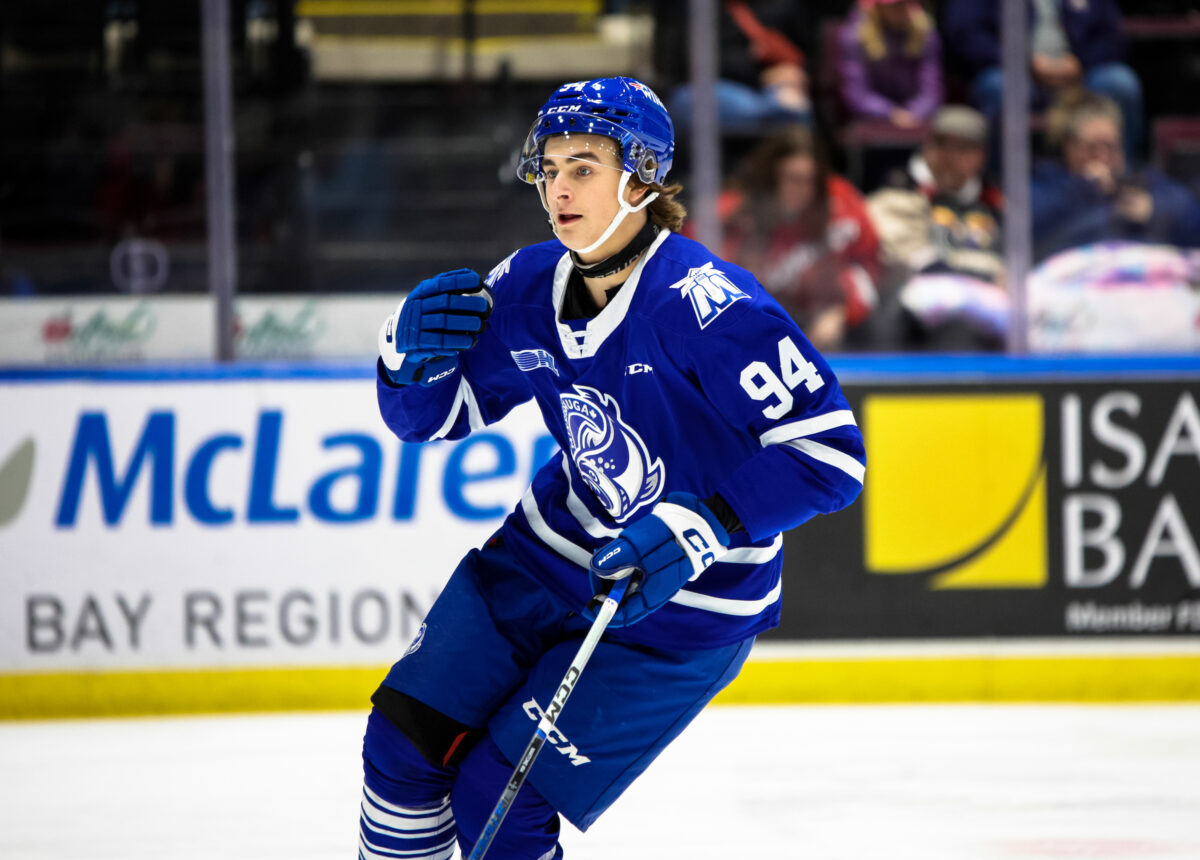
6. Brady Martin, C, Soo Greyhounds (OHL)
Brady Martin can alter the flow of a game in so many ways. He’s got a great shot that some have said is nearly NHL-ready, and he is surprisingly creative with the puck, as shown by his 33 goals and 72 points this season. But he’s also a tireless worker, incredibly aggressive, and a devastating hitter, making it a nightmare to go toe-to-toe with him. His performance at the U18s was a big eye-opener for many (myself included), and he won a few more fans when he said he wasn’t planning on attending the decentralized draft in L.A. because he had work to do on the family farm. No wonder he’s a great worker and is immoveable on the ice. If a team is looking at Martone and hoping he becomes a power forward, they should instead look at Martin. He’ll be a much better fit for that role in the NHL. – Reimer
7. Anton Frondell, C, Djurgårdens IF (HockeyAllsvenskan)
There were questions about Anton Frondell due to his health. However, his production in the second half almost brought him close to a point-per-game pace as an 18-year-old in the HockeyAllsvenskan with 25 points in 29 games. His awareness, drive and compete really showed at the pro level. He’s able to expose open lanes to attack swiftly, and when he gets to the high-traffic areas, he’s difficult to contain. He can pull off moves quickly and accurately and protects the puck well to fend off the opposition. – Baracchini
8. Victor Eklund, LW, Djurgårdens IF (HockeyAllsvenskan)
Victor Eklund is quick and deceptive with the puck. He’s a precision shooter who picks his opportunities and capitalizes on chances in close and from the perimeter. He’s a water bug out there with a ton of energy, and it shows. He’s always looking for the next play to unfold. He can cycle the puck inside the zone and can fool defenders off the rush, making him a dangerous option for any team. – Forbes
Related: THW 2025 Mock NHL Draft Round 1: Our Writers Make Their Picks
9. Jake O’Brien, C, Brantford Bulldogs (OHL)
Jake O’Brien is a brilliant puck-mover with a very high hockey IQ. He positions himself well on offence and defence, giving him a big advantage in creating turnovers and catching loose pucks. I think he can slip into the background a little bit because he is so focused on feeding the puck to his teammates, which he does arguably better than anyone else. I just wish he were a better skater. He’s not bad, but if he could add another element to his skating, whether that’s improving his edgework or agility, he could be a top-five player in his draft class. – Reimer
10. Jackson Smith, LD, Tri-City Americans (WHL)
Smith is a two-way defender who can play on both sides of the puck and makes an impact on the game regardless of the situation. He closes the gap on opposing players and makes it tough for them to approach the net. However, he has holes in his game when under pressure defensively. If Smith can clean up those gaps, there’s no question he would be a strong defensive option in this draft. – Forbes
11. Lynden Lakovic, LW, Moose Jaw Warriors (WHL)
Lynden Lakovic has the perfect blend of size, strength and speed. He can create separation and break free from opposing players with his long stride and agility, and he has a powerful shot to boot. He uses his size to his advantage very well in puck battles, engaging physically and excelling along the boards or below the goal line, imposing his will. He has a lightning-quick and powerful wrist shot from far out and can do a lot of damage anywhere in the offensive zone. – Baracchini
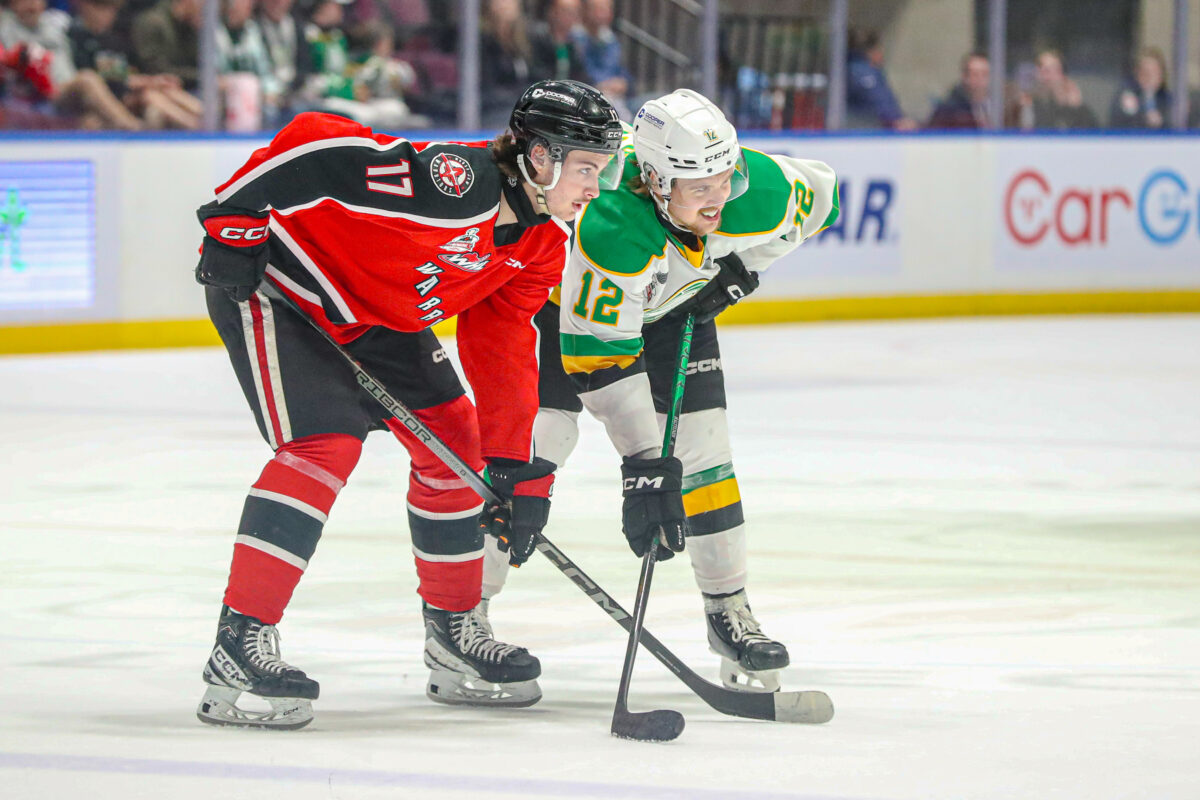
12. Kashawn Aitcheson, LD, Barrie Colts (OHL)
Kashawn Aitcheson might be one of the most impactful players outside of the top 10. He loves to throw his weight around, but he’s also good with a puck, earning the nickname “Mr. Clutch” thanks to his ability to score when needed. This season, he led all OHL defencemen in game-winning goals with six, surpassing last year’s 11th overall selection, Sam Dickinson. There are other defencemen available who have better offensive games and skate better than Aitcheson, but no one has such a complete style that can change the flow of the game in so many ways. – Reimer
13. Roger McQueen, C, Brandon Wheat Kings (WHL)
McQueen is a massive wild card in this draft. He had a strong start before missing months with a lower-body injury. When he returned, he was okay but not the dominant presence he was before. While his draft stock may take a hit, there’s still a team that will want to draft a highly competitive and engaging centre that stands at 6-foot-5, 197 pounds. Finding a player with his blend of size, physical play, and offensive awareness is difficult. – Baracchini
14. Radim Mrtka, RD, Seattle Thunderbirds (WHL)
Maybe one of the more underrated in the top 10 is Mrtka. He skates well and is a two-way defender who can also provide offense. He has good angles, an active stick and can win puck battles along the boards. As a right-shot defender, he will be sought after for his skill and transitional game, possibly pushing him into being the second defenceman off the board ahead of Smith. – Forbes
15. Cole Reschny, C, Victoria Royals (WHL)
Similar to Aitcheson, Cole Reschny makes things happen on the ice. He’s a brilliant tactician who can conduct the flow of a game when he has the puck. He might not stand out as much as Braeden Cootes or Smith, who really steal the spotlight, but he’s very effective at the little parts of the game that often go unnoticed. Reschny skates very well, plays a strong two-way game and can take a lot of punishment despite being on the smaller side. I could see him becoming a reliable second-line centre in the NHL in the right situation. – Reimer
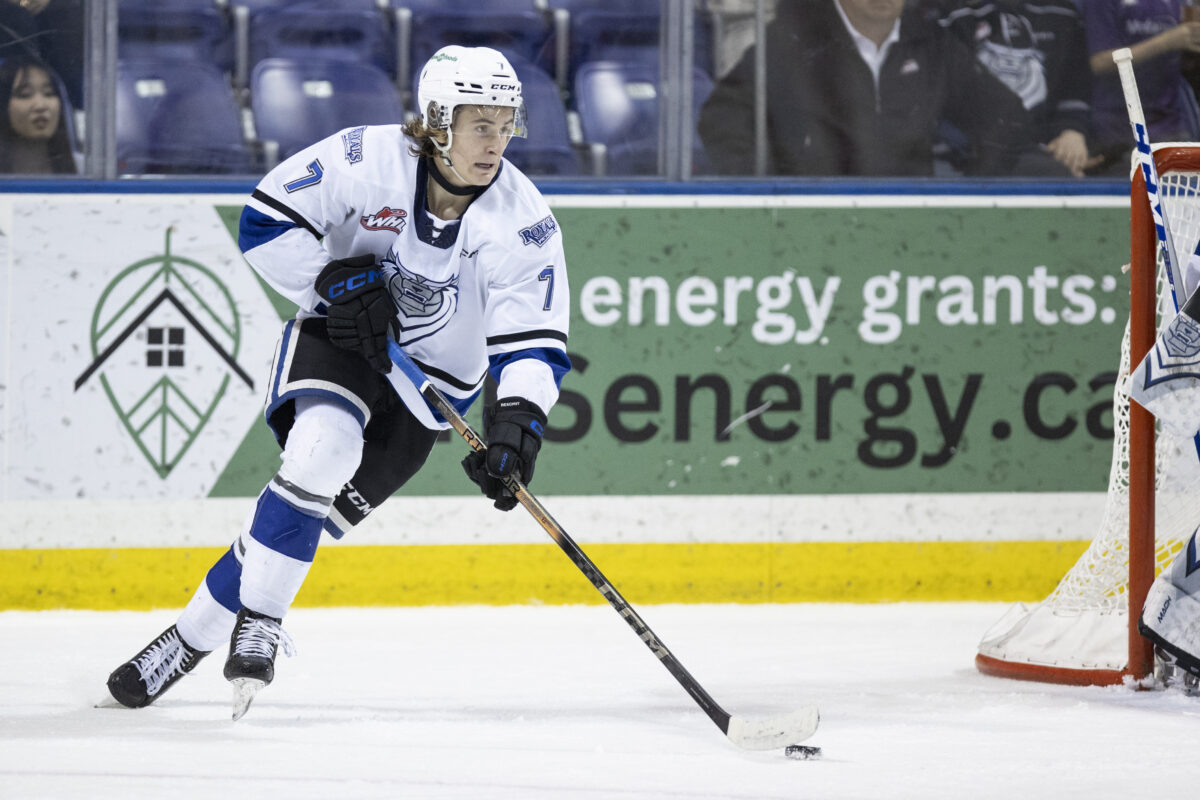
16. Braeden Cootes, C, Seattle Thunderbirds (WHL)
After a 63-point season and 12 points in a gold medal effort at the U18 Championship, Braeden Cootes is one of the hardest-working players in this draft class, as he’s relentless hunting down pucks, establishing attacks and playing a complete 200-foot game. He is extremely persistent and constantly comes out on top in puck battles. He plays heavy, is very intense and defensively, and he’s just as effective at hustling back to help on the backcheck. – Baracchini
17. Justin Carbonneau, RW, Blainville-Boisbriand Armada (QMJHL)
I’ll admit I was a bit harsh on Justin Carbonneau in my April ranking, questioning his vision and decision-making because of his shoot-first mentality. His positioning is quite good, as he’s often in the right place to receive a pass for an excellent scoring chance, or he can move the puck to an open teammate. He’s not the most creative player, but he doesn’t have to be; he’s bullish on the puck, always looking for a chance to shoot and using his strength and size to help create space, which probably comes from his football background. He doesn’t have the nicest skating stride and looks a bit laboured, but he still has a good top speed that can win footraces. – Reimer
18. Malcolm Spence, LW, Erie Otters (OHL)
Malcolm Spence’s speed and work ethic are what make him effective with the puck, constantly driving hard to the middle and creating opportunities for others. He has a solid two-way game, and his drive and pace of play are a big factor in his success. He provides great support for his teammates, and his strength stands out in plays below the goal or on the boards to win battles. – Baracchini
Sign up for our FREE NHL Prospects & Draft Substack newsletter

19. Benjamin Kindel, RW, Calgary Hitmen (WHL)
Benjamin Kindel knows how to score, and he does it frequently. After putting up 99 points in the regular season with the Hitmen, he led the team in the playoffs with 15 points in 11 games, including eight goals. He was also very good at the U18s for Canada, registering seven points in five games en route to a gold medal. Yet, despite Kindel’s continued success, he remains 19th overall. Part of that is the unfortunate consequence of others jumping ahead, but it’s also due to the lack of strength in Calgary’s opening series against the Saskatoon Blades. He made some incredible decisions with the puck but also got pushed out of battles, forcing him to play more on the perimeter. I don’t think that will be a problem moving forward, as he’s shown a lot of intelligence with and without the puck, but others were just a bit more impressive. – Reimer
20. Cameron Reid, LD, Kitchener Rangers (OHL)
Although he didn’t put up big offensive numbers, Reid was still one of the more productive defenders in the OHL, finishing 10th overall with 54 points in 67 games. He plays a simple game with strong execution as a defender. He isn’t flashy, but he’s smart and tends to make the right play in any situation. He’s quick and strong on puck retrievals and can rush a play or breakout effectively. – Baracchini
21. Bill Zonnon, LW, Rouyn-Noranda Huskies (QMJHL)
I have always been impressed with the power and skill that Zonnon brings. He’s a high-motor player with blazing speed and skill. He’s insanely competitive in 50-50 puck battles. He anticipates plays very well to force turnovers, does a great job of pushing defenders back and attacks quickly to open things up on the rush. He also has no problem attacking one-on-one and drives hard to the net. He finished seventh in the QMJHL scoring, with 83 points. – Baracchini
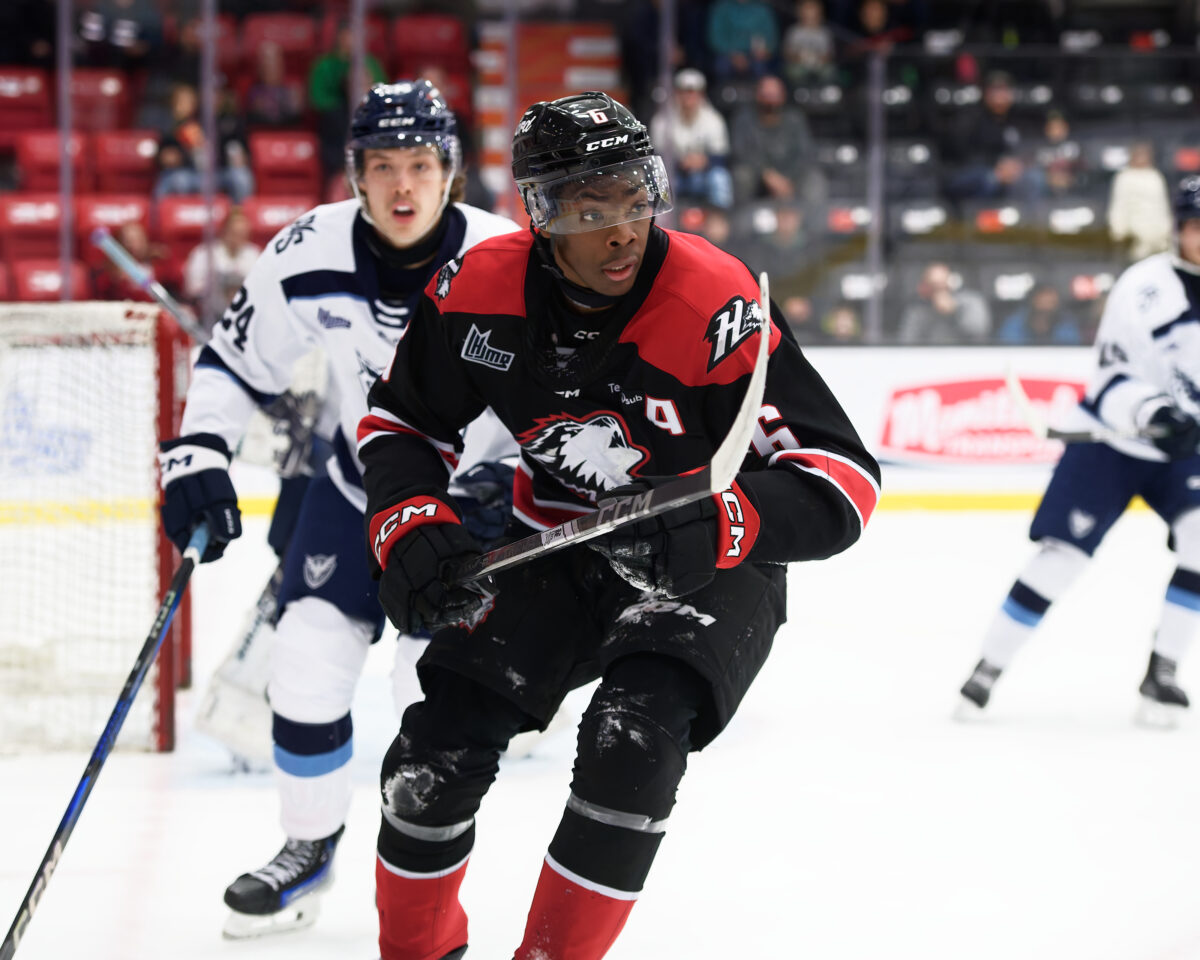
22. Carter Bear, C, Everett Silvertips (WHL)
Carter Bear shouldn’t be this low. He’s a hard worker, has a great offensive game, and uses his physicality effectively to create turnovers. Before he partially severed his Achilles tendon, he was playing an NHL-style game and made the Everett Silvertips an impossibly difficult team to handle. But Achilles’ injuries are not fun. They have a very long recovery time and often force the afflicted athlete to play at a slower pace than they once did. Just look at Peyton Krebs, who also cut his Achilles before he was drafted and has struggled to live up to his pre-draft potential. Max Pacioretty and Anthony Duclair also suffered Achilles injuries and haven’t been the same since. The only one who came back better than ever was Erik Karlsson in 2013. That doesn’t give me a lot of hope that Bear will return to full force next season, but his skill combination is worth the gamble. – Reimer
23. Cullen Potter, LW, Arizona State (NCAA)
At 5-foot-10, 171 pounds and his 22 points in 35 games with ASU may not be eye-popping, but Cullen Potter is always creating and generating chances when he’s on the ice, with his strong skillset and fantastic play-driving. He wants to be in control and be involved as much as possible. Potter is a threat on the rush, anticipates plays on the backcheck, and his speed allows him to cut in and get around defenders with his movement. His puck skills and handling instantly stand out, as he can easily manipulate plays and fool defenders. – Baracchini
24. Logan Hensler, RD, USA U18 (NTDP)
As the season progressed, I think Logan Hensler figured out his game and where he was most effective. He’s not a puck carrier or a rush defender. His mobility is good, but he doesn’t have the puck skills to be a high-end offensive defenceman. However, when he plays a simple, defensive style, he’s one of the best defencemen in his draft class. When his team is on the attack, he patrols the blue line, ready to catch a pass or keep the puck in the offensive zone. It also makes him ready for a breakout, where he excels at positioning himself between the player and the net, forcing them to cough up the puck or get pushed into the boards, regardless of where they start. He looks so calm and unaffected by all the changes around him, and while he probably won’t be a top-pairing defenceman, he’s got a great foundation. A safer pick, but still a good one. – Reimer
25. Sascha Boumedienne, LD, Boston University (NCAA)
If there was anyone who needed a big second half, it was Sascha Boumedienne. He looked more confident with his puck-moving abilities and was more impactful overall. That carried over into the U18 Championship, where he finished second in tournament scoring, with 14 points and was named to the All-Star team and the top defender. The potential is there with his ability to lead an attack and make smart plays when he has possession. – Baracchini

26. Joshua Ravensbergen, G, Prince George Cougars (WHL)
Joshua Ravensburgen is extremely athletic in the crease, making long stretch saves and taking up a good chunk of the net with his 6-foot-5, 190-pound frame. He has strong lateral movements and a great eye to track the puck through traffic. While his .901 save percentage and 3.00 goals-against average may be average, he had a 33-13-4 record and was a very important player for the Cougars. – Baracchini
27. Jacob Ihs-Wozniak, RW, Luleå HF J20 (Nationell)
Ihs-Wozniak has bounced around the draft rankings this season, going from a sure-fire first-rounder to a definite second-rounder or lower. Lately, he’s been creeping back up and has landed somewhere in the middle. It’s easy to love his big, powerful shot and his impressive frame. Now, he just has to round out the other areas of his game. – Reimer
28. Jack Murtagh, C/LW, USA U18 (NTDP)
Jack Murtagh remains my favourite player out of the United States Development Program (NTDP) thanks to his speed and energy. He slid to the background at the U18s and was overshadowed by L.J. Mooney and William Moore, but he continued to bring his tireless work ethic to his line. I think his potential likely tops out as a second-line winger in the NHL, and he might be more suited for a third-line role, which is why he’s lower in my first round, but I’ll still be paying close attention to where he goes on draft day. Joining the right team could set him on course to be a dangerous player in the future. – Reimer
29. Blake Fiddler, RD, Edmonton Oil Kings (WHL)
While he’s not an offensive defenseman, Blake Fiddler is a great skater for his size and has no problem leading an attack when he has the opportunity. He’s a stalwart on the backend, as he’s a tough customer to go up against one-on-one. He can make big-time checks, is aggressive to take time and space away from the opponent and also has some strong offensive tools. He’s a responsible player who can handle big minutes and a heavy workload as a result. – Baracchini
30. Vaclav Nestrasil, RW, Muskegon Lumberjacks (USHL)
Nestrasil caught everyone’s attention in the second half. His power-forward style and stature are truly impressive, showing the physicality, smarts, offensive awareness and speed to be extremely effective in that role. He’s a great playmaker, having eyes in the back of his head and spotting seams perfectly. He’s got great poise and was a standout in his first season in North America, winning the USHL title. He flew under the radar, but teams are on notice now. – Baracchini
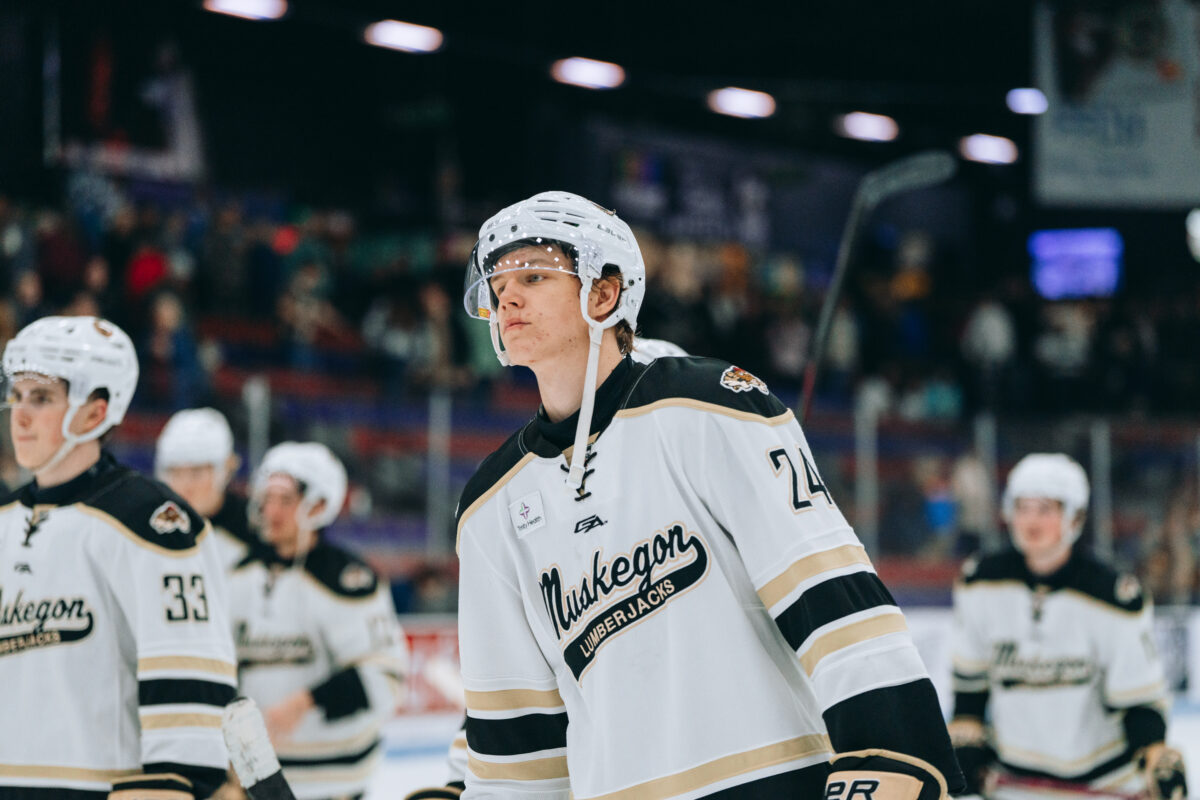
31. Cameron Schmidt, RW, Vancouver Giants (WHL)
If only Cameron Schmidt were a couple of inches taller. He plays so intensely, using speed and aggression to make things happen for the Vancouver Giants. He was easily the team’s best player in both the regular season and the playoffs, where he was practically unstoppable. At the U18s, some of his biggest weaknesses were put on full display, though, namely his ability to get pushed around by bigger, stronger, more defensively sound players. He still has a ton of strength for his 5-foot-7 frame, which he showed off at the NHL Combine, and doesn’t lose nearly as many battles as you’d expect from a player that small, but it’s still a concern. – Reimer
32. Milton Gästrin, C, MoDo (J20 Nationell)
Milton Gästrin displays a tremendous amount of compete and has a strong two-way game. He’s relentless when pursuing the puck, and his high-end motor shows that. He’s constantly using his size to win battles, or using the combination of his hands, speed and edgework to power through defenders and generate plays. He doesn’t possess the high-end skill of other players, but he’s effective and can be relied upon in any situation. – Baracchini
Other first-round considerations: Eric Nilson, Nathan Behm, Jack Nesbitt, William Moore, William Horcoff


